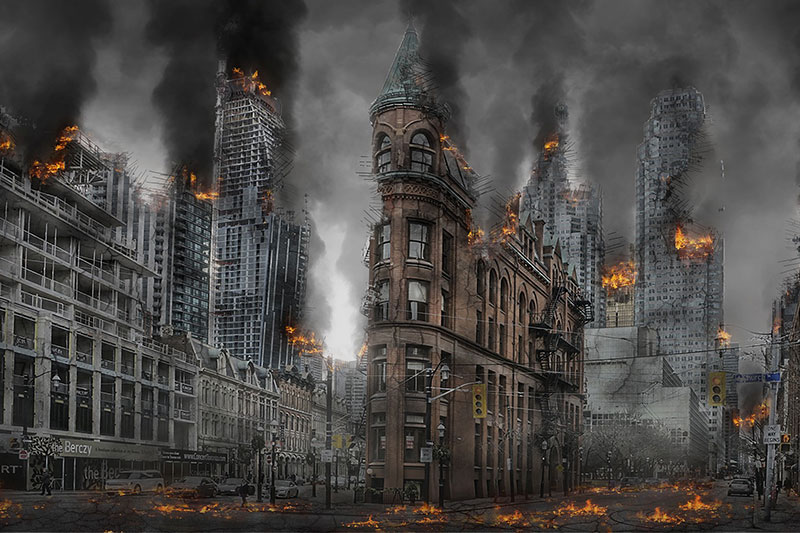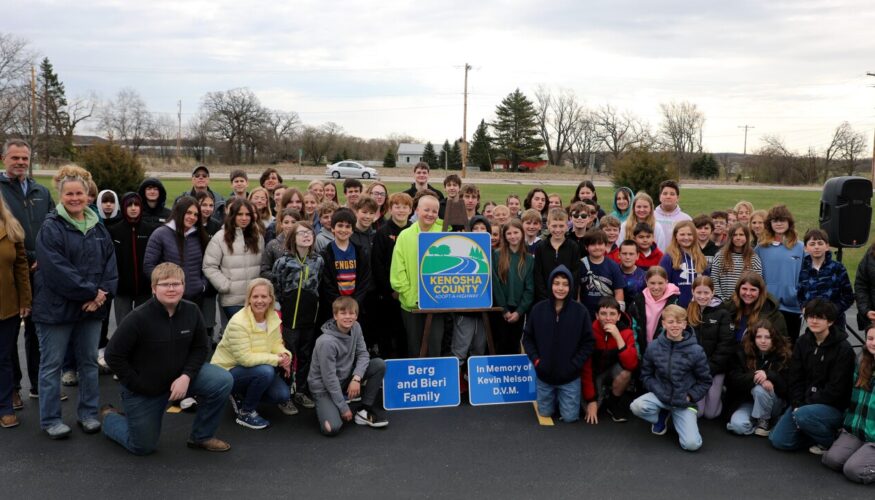What a disaster!
While that could be the name of my periodic column, it actually is just the subject of my latest rumination on movies.
We all have a guilty pleasure, that genre of movies or series of movies that are not quite respectable and you are somewhat embarrassed to admit you enjoy. For me, that particular genre is the disaster movie. I have loved disaster movies since the time my mother took me to the theater when I was eight years old to see “The Poseidon Adventure.”
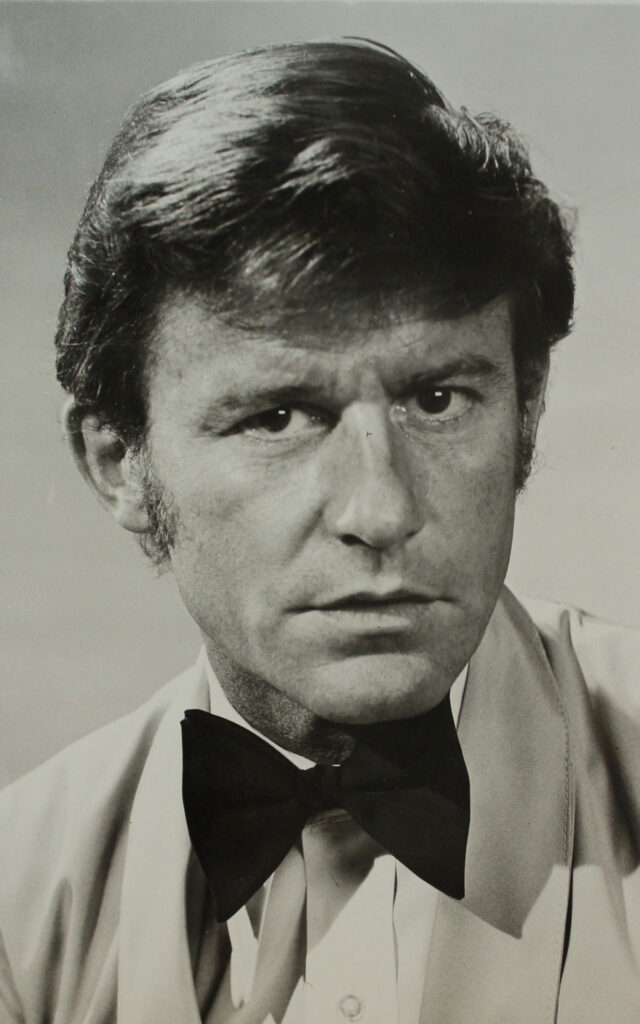
I remember crying when the boat overturned and all the people were falling and screaming, and being heartbroken when Roddy McDowall died. Not Roddy! Not the boy from “Lassie Come Home!” You would think that for as traumatic as “The Poseidon Adventure” was for a young boy, I would be reluctant to ever see another disaster movie.
But I couldn’t get enough, and I still go out and see practically every disaster movie released. I admit – I even paid to see “Skyscraper” and “Geostorm.” That’s why they’re called guilty pleasures.
What is the lure of disaster films? Generally, they are not especially well-written, the characters are usually under-developed, the acting is often over the top (I’m talking about you “2012”), the direction can be over-reliant on special effects, and the effects can sometimes be not that special. So what exactly is it that attracts me? Is it the old “it’s so bad, it’s good” argument that usually for me holds no water?
After all, if it’s bad, it’s just bad. I’ve seen some critics call it “disaster porn” which I find a fairly vulgar and unfair term, but I’m not so biased that I don’t somewhat appreciate the sentiment behind it.
First of all, let’s just get it right out there. People who watch disaster films are there to see buildings crumble, fires explode, oceans flood, and airplanes crash. And the more recognizable the landmark, the better.
I’m not going to even try to hoodwink you and tell you the attraction is the elemental struggle for survival of a plucky band of misfits. We all know that’s hogwash – we like to see things blow up real good. So the special effects are absolutely essential to the success of a disaster film.
Nobody went to see “The Day After Tomorrow” because of the father-son relationship; if that’s what you want, watch “A Bronx Tale.”
Before the advances in computer technology, disaster films relied on scale models to create their catastrophic scenarios. What would have taken months of model building (and destruction), today can be created on a computer screen with a few keystrokes. (Okay, I’m minimizing the quantity of work involved, but you get the gist.)
It probably explains why there are so many more disaster films made today than were made 50 years ago – it is simply easier and less expensive to make them. And the quality of the thrills is so much greater. Would it have even been possible to make a film like “2012” back in the day when Irwin Allen was making disaster films? Sure, but not on the same scale and not with the same authenticity (I can’t believe I’m using that word in a column on disaster movies).
I’m not a psychologist or sociologist, and thus have no insights to provide on the workings of the human mind or on mob mentality, but there has to be some significance to the popularity of disaster films and mental health. After all, what would you say if I told you we were going out for an evening of entertainment to watch the destruction of the entire world and the deaths of untold millions of people?
And by the way, that is totally acceptable, as long as the five people in the family who are at the center of the film survive. And don’t forget the dog – the family dog must make it too! Several thousand people have perished in the most horrible of circumstances, but God forbid that Rover should bite the dust.
Is there something wrong with me, and all the other people who enjoy disaster films? Why is it so easy to ignore the pain and suffering and profound grief which is presented in such spectacular fashion right in front of our eyes? Why are we able to compartmentalize the empathy we have for the main characters from the delight we get in seeing the destruction of a major city, like San Francisco in “San Andreas?”
Thus is the anachronism of the disaster film. They are very popular while at the same time not usually well-made (only three have ever been nominated for Best Picture), they are usually devoid of any kind of real character development and they are entirely reliant on increasingly absurd special effects. But love them I do!
My five favorite disaster movies:
The Towering Inferno (1974)
The second disaster movie to be nominated for Best Picture (it lost to the “The Godfather Part II” – go figure). I still periodically revisit it, and can honestly say I enjoy it as much today as I did when I first saw it at age 10.
First, what a cast – Paul Newman, Steve McQueen, Faye Dunaway, William Holden, Fred Astaire, Jennifer Jones, Robert Wagner, Robert Vaughn, and let’s not forget O.J. Simpson, back when he was a heroic figure. When you talk about star-studded disaster films, “The Towering Inferno” has to be at the top of the list. The story and characters are, as usual for disaster films, window dressing to get from one action set piece to the next. But what astounding set pieces, and they still hold up well today: the scene in a stairwell that explodes; a daring rescue of a scenic elevator hanging by a cable; the breaches buoy rescue sequence (just thinking about getting in that thing is enough to keep me out of tall buildings); and the climactic blowing up of water tanks on the roof. It’s remarkable to think that the entire film was made by using scale models and matte paintings, and the work is pretty darn seamless.
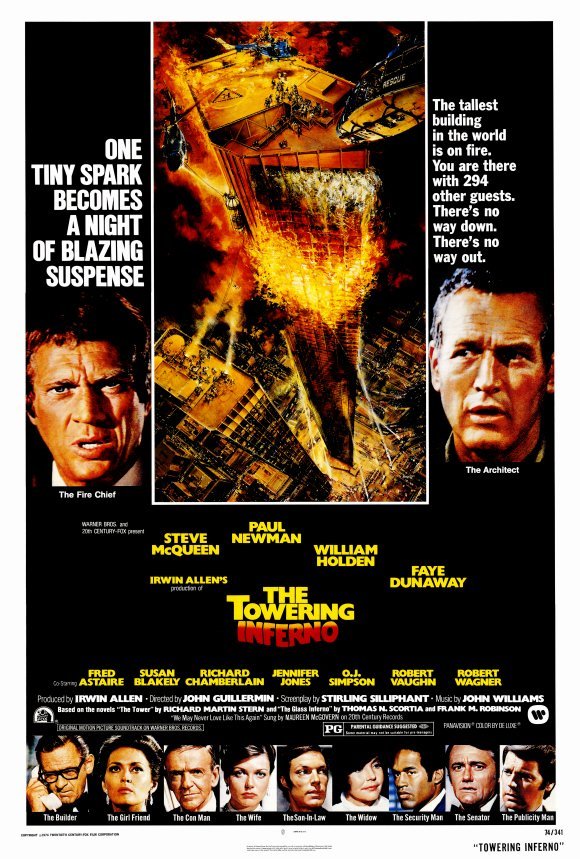
The view of San Francisco from the promenade room on the 135 th floor? A cloth painting wrapped around the set. The fictional building itself? The Bank of America building in San Francisco with an additional 50 stories added via matte paintings. The storyline is pretty simple – a brand new skyscraper is having a dedication party for select guests in the 135th floor promenade room when a fire breaks out in a storage closet some 60 floors below. The fire quickly spreads throughout the building, threatening the guests on the top floor. Paul Newman is the architect and William Holden is the building contractor, while Steve McQueen is the fire chief. I can honestly say they don’t make movies like this anymore; today, it would all be done with CGI, but it wouldn’t be done any more effectively.
Head scratching moment(s) – I love some of the dialogue in this movie, especially the love scenes between Newman and Dunaway and Wagner and Susan Flannery. Not exactly Romeo and Juliet. I also love the piece of dialogue from an extra (blink and you’ll miss it) when she says “we were supposed to have fire drills!” Who says disaster movies can’t be funny? Finally, and not funny at all, this movie has a whopper of a Carol Lynley moment. What is a Carol Lynley moment? It is the scene when a character or characters in a disaster movie do something so annoyingly stupid and counter to survival that you immediately spend the rest of the movie hoping they die. Why Carol Lynley? See “The Poseidon Adventure” further down this list. In this movie such a moment occurs when two female characters break away from the group and run under a helicopter trying to land in high winds on top of a 135 story building, causing said helicopter to crash and burn. Later, these two women are in the scenic elevator scene and I was so hoping they would fall out of the elevator.
Titanic (1997)
One of the most successful movies of all time, it set world-wide box office records and won a record-tying 11 Oscars, including Best Picture, the one and only disaster film to ever win the top prize. This is a story about the Titanic, the so-called unsinkable ship that hit an iceberg in the North Atlantic waters off Newfoundland on its maiden voyage and sank two hours, 40 minutes later with the loss of more than 1,500 lives. The movie focuses on two fictional characters, an upper class woman named Rose (played by Kate Winslet) pressured by her mother to marry a wealthy suitor, and a lower class, free-spirited man name Jack (played by Leonardo DiCaprio) who intercedes to save her when attempting suicide. Their love story is at the center of the film, and differentiates this movie from other disaster films – this movie is character driven and the actual disaster sequences do not occur until about two hours into the movie. The film made a star of DiCaprio but it was Winslet who received the Oscar nomination for her acting. The opening shots of the Titanic are truly awesome, and the entire sinking sequence in the last third of the movie is one of the most impressive use of special effects ever conjured for the screen.
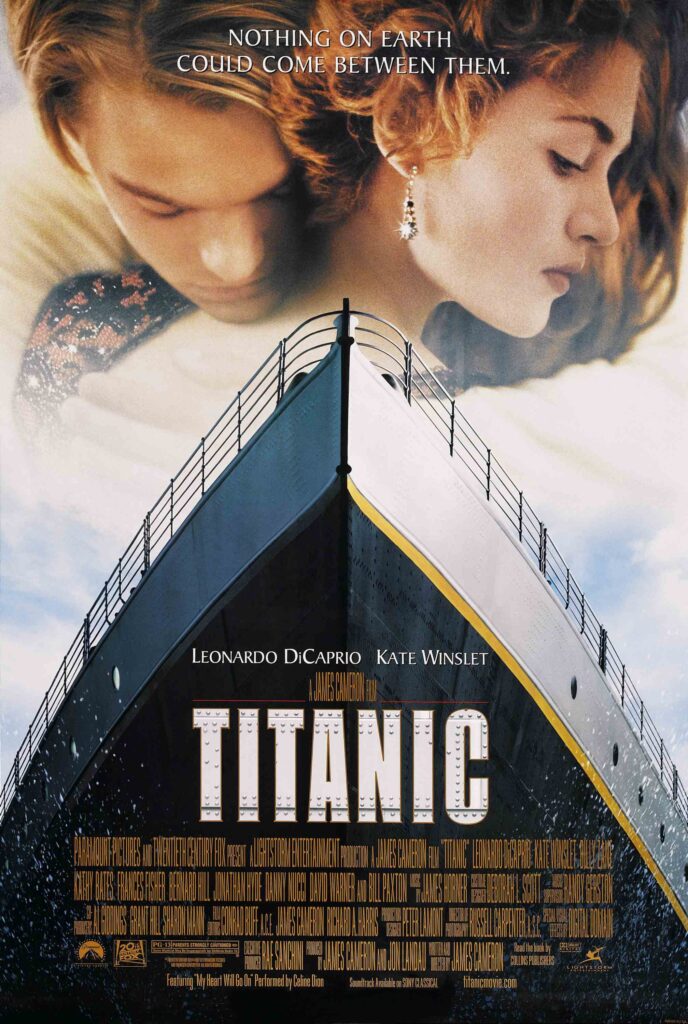
Head scratching moment(s) – Any scene with Billy Zane, who has to be one of the most annoyingly shallow actors ever on screen. I could not for one instant believe that any woman’s mother, no matter how cravenly materialistic, would want her to marry such a man.
Knowing (2009)
Oh how the critics hated this movie, with the notable exception of Roger Ebert. Well, Rog, I’m with you buddy. What the critics found preposterous, ludicrous and ridiculous (three words in just one sentence of one critic’s review), I found quite interesting and compelling. Of course it’s ludicrous – so what?! It’s a disaster movie with sci-fi undertones and supernatural and quasi-religious gobbledygook thrown in! I never once found it less than totally entertaining, with some really cool action set pieces involving a crashed airliner and subway train, not to mention the climactic cataclysm. The movie stars Nicolas Cage as a science professor whose kid brings home a paper from a school time capsule with seemingly random numbers scrawled front and back.
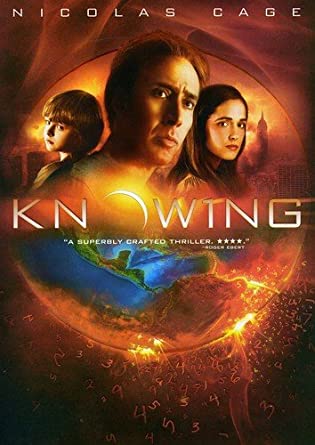
Cage begins to suspect that the numbers have a pattern that correspond to disastrous historical events. Do the remaining numbers in the sequence portend future disasters? And what about the strange, eerie figures seemingly stalking Cage’s young son? I went and saw this movie fully expecting it to be awful, and found it to be an intelligent, well-acted, and suspenseful combination sci-fi/disaster film. Movies like this should be commended not criticized; it was an ambitious and imaginative little wonder.
Head scratching moment(s) – Leaving the theater and wondering why the critics were so negative about this movie. I thoroughly enjoyed it.
The Poseidon Adventure (1972)
First of the 1970s era disaster films produced by Irwin Allen, the king of disaster movies. After this movie and “The Towering Inferno” the quality of the films rapidly deteriorated and led to disenchantment with the entire genre, and it was not until a resurgence in the late 1990s that disaster movies became popular again. This is the story of the S.S. Poseidon, a ship on its final voyage that is capsized after being struck by a rogue wave, and the small band of survivors who climb up through the bottom of the ship to hope for rescue. With an all-star cast that included Gene Hackman, Ernest Borgnine, Shelley Winters, Jack Albertson, Red Buttons, Leslie Nielsen, and the aforementioned Carol Lynley. Today, the action sequences, especially the scene when the boat capsizes, may seem quaint, but the characters are actually mostly well-drawn and well-performed for a disaster flick, especially a quite sympathetic performance by Winters.
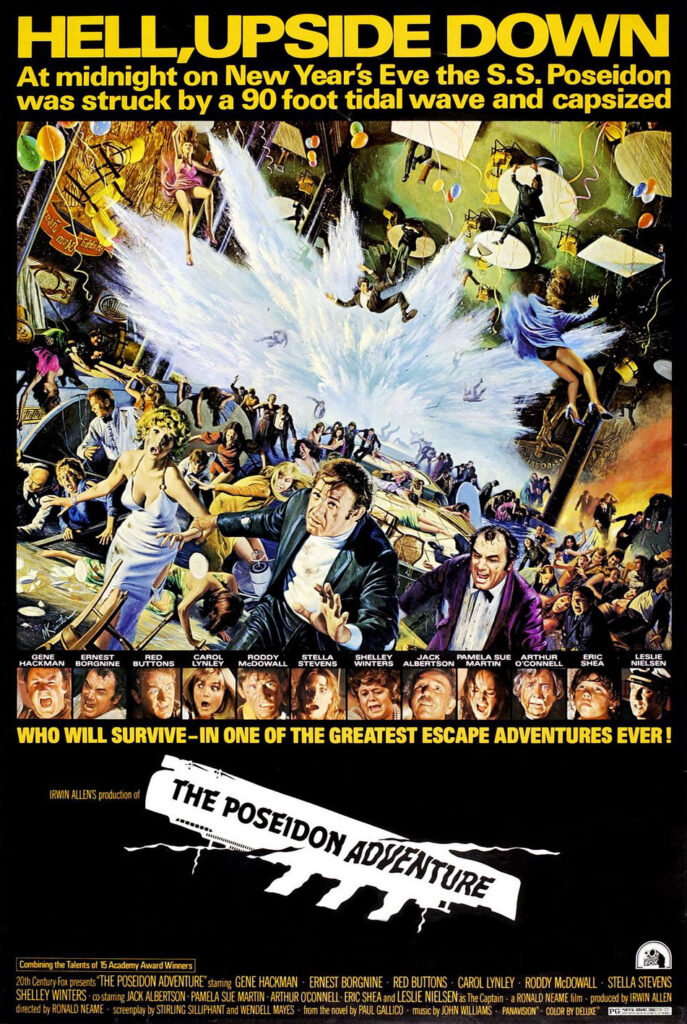
Head scratching moment(s) – Back to Carol Lynley. Almost from the moment she appears on screen, she has to be one of the most irritating movie characters of all time. If she says “I can’t go on” or “just leave me” one time in this film, she must say it a thousand times. And basically after the second time, I was yelling for the rest of the cast to take her up on it. I have a theory that basically says if you aren’t willing to do the minimum to survive in a disaster film, you haven’t earned the right to. And speaking of yelling, is it just me or do Hackman and Borgnine spend the entire movie yelling at each other? I can’t recall a single instance when the two say a civil word.
Dante’s Peak (1997)
The first and best of two volcano movies released in 1997, the other being “Volcano” (now there’s an original title). This one is about a volcanologist (Pierce Brosnan) sent to a small western town to investigate some suspicious activity on a local volcano. Linda Hamilton plays the town mayor and coffee bar owner with two cute kids and an irascible mother-in-law (think Harry Truman of Mt. Saint Helens fame). Of course the mayor and the volcanologist fall for each other, and of course that suspicious activity is an omen of cataclysmic events to come. The scenes of the eruption and destruction are pretty impressive, and the characters made sympathetic enough by a game cast to keep the suspense, shall I say… flowing.
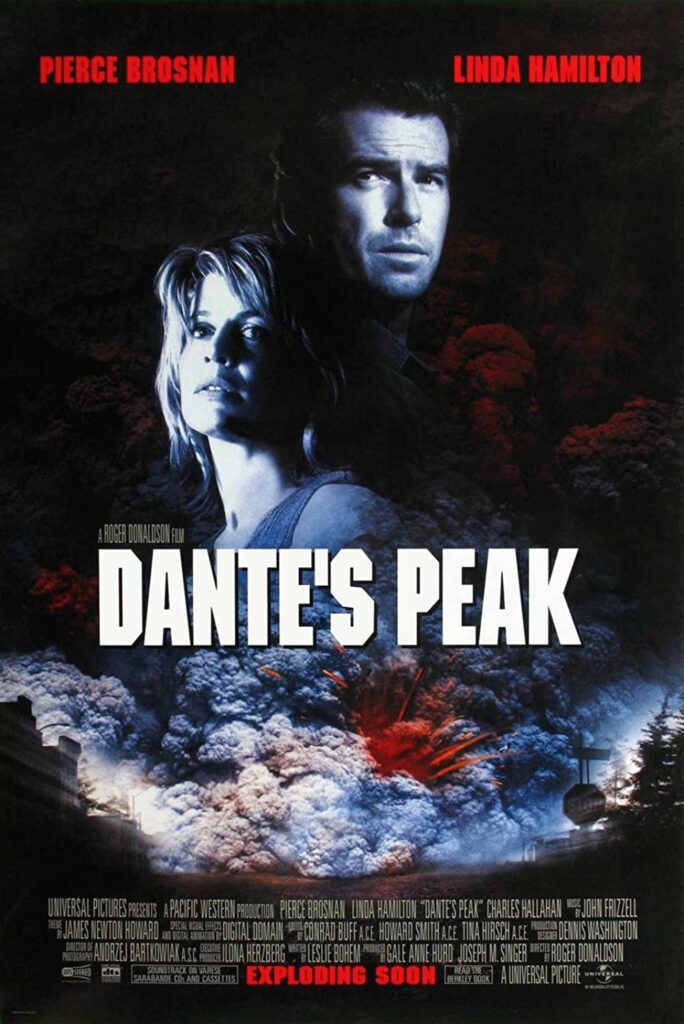
Head scratching moment(s) – The family is at Grandma’s cabin on the mountain and the kids are looking for the dog which has conveniently disappeared when suddenly an ocean of lava comes through the cabin and they escape just in time (without the dog) to a small boat on the lake.
They motor across the lake which has turned acidic and is eating the boat and motor. They barely make it across the lake before the boat sinks, hike across the mountain to a ranger station and hot wire a truck, only to come across a lava flow that blocks the road. They speed over the lava flow, only to get stuck and the truck tires start to melt and catch fire. They are able to get the truck moving again when, lo and behold, the dog appears on a rock overlooking the lava flow, and the dog jumps into the bed of the truck! Even Pierce Brosnan has to break into a mischievous grin at the utter ridiculousness of this scene.
I can think of no better way to end this article on disaster films than the dog scene from Dante’s Peak. It perfectly encapsulates why I love disaster movies. The combination of special effects, pluck and sheer nonsense, along with a tongue in cheek recognition that the filmmakers are very much aware of how absurd it all is. The key to enjoying a disaster film is to check reason at the door, sit back and let the destruction in.
